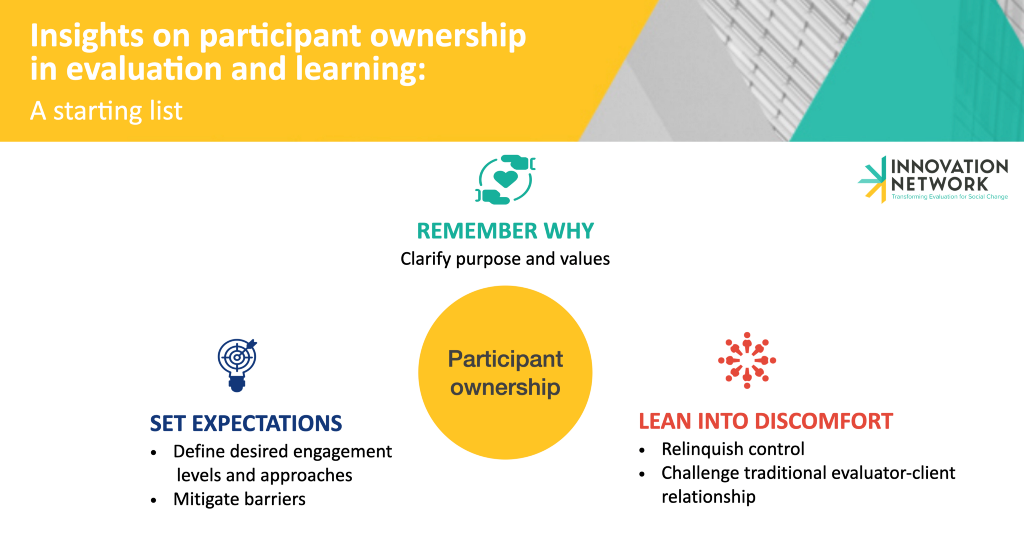This is an Eval Central archive copy, find the original at medium.com/innovationnetwork.

A starting list
Earlier this year we were asking the representative of a grassroots organization whether and how they would be interested in being involved in the learning and evaluation work of one of our foundation clients. They told us that what is truly real is land, water, nature, and animals, not professional titles. Their words stayed with me, reminding me how my evaluation and learning practice truly matters when it serves the communities closest to the issues and solutions that it seeks to understand, as it is these very communities who know what is “truly real” about their experiences, relationships, and lands.
In the past, this was not what I understood my practice was about, or how the field of evaluation conceived its mission. As many outstanding practitioners like Jara Dean-Coffey, Dr. Nicole Bowman, Dr. Geri L. Peak, Dr. Bagele Chilisa, and Dr. Donna M. Mertens have shown, overtly or under the cloak of pursuing the western-colonial construct of objectivity, evaluation has historically centered the learning needs and interests of those groups — usually public administrations and philanthropic funders — that held the most structural and positional power in the ecosystem of those involved in the process. I, too, for many years, understood the primary beneficiary of my work to be whoever had commissioned it. Bringing the lived experience and voices of those most impacted into learning and evaluation was a “nice to-”, as opposed to a “must-have”.
As the Equitable Evaluation Initiative has taught our field, reframing who should be the ultimate beneficiaries of our learning and evaluation work makes sense for everyone. For administrations and foundations that want to ensure the impact of their investment in non-profits, advocacy efforts, and communities, but even more so for those engaged in the evaluation, who are the very same communities and organizations that funders and their investments seek to support. An evaluation approach that defers participants’ or grantees’ learning needs and ways of knowing provides communities with the power, tools, and resources they need to self-determine, tackle both internal and external challenges, and create stronger solutions for themselves. In doing so, it also truly fulfills the ultimate scope of public or philanthropic endeavors aimed at furthering equity and social justice by effectively supporting the communities and issues they seek to elevate. Understanding and truly believing in this now, as an evaluation and learning practitioner, my purpose for practicing participant ownership in projects is also driven by a desire to advocate for power to be in the hand of communities who have the most experience and knowledge about the very issues that affect them directly.

This may sound wonderful but, in actuality, how do we do this? It is hard to make learning and evaluation valuable and engaging to communities because for so long our practice has been far removed from their ways of working, learning, and knowing, taking away from their power to create the change they envisioned. Also, while evaluators and funders are increasingly seeking to engage and center partners, grantees, and clients in their evaluation processes, there is no wholesale approach to participant ownership. The characteristics and interests of the communities we wish to defer to, the nature and quality of relationships between parties involved, and the degree to which evaluators and funders are willing to cede power are among the many factors that influence the design and implementation of projects that authentically center the communities closest to the issues of focus.
So, while it would be disingenuous to say that we are not implementing and learning at the same time, I think it is crucial that we share what we are learning about what it takes to practice participant ownership, not only to further this practice but also to seek the feedback and invite the accountability of those organizations and communities whose learning we seek to facilitate. It is this desire to be in community on this journey that leads me to share and invite your feedback on a few lessons we, at Innovation Network, have learned across the pilot projects we are working on :
1 Participant ownership, from start to finish, necessitates that we ask and remind ourselves of why we are doing this and why this work is important. So, at the start of each project, we have a discussion among ourselves and with our clients about the purpose and values that we want to underpin it (thank you, Heather Krause and Katie Fox for teaching us the importance of doing so). We use the principles distilled in these conversations as a compass throughout a process that may often get complicated as we challenge preconceived notions of power within evaluation and learning. Further, remembering that we do this to shift power to communities to drive involvement that is meaningful to them, safeguards us from perpetuating cosmetic or performative approaches and processes.
2 Also, at the onset and throughout an engagement, it is crucial to set clear expectations for those engaged in the learning or evaluation project. Most often our client is a foundation, while the groups running the organization or implementing the program or activities that we seek to evaluate and learn from are the evaluation participants. To ensure expectations are clear and transparent from the beginning, we have an open conversation with the foundation client about the importance of participant ownership and the need to promote equity within these processes. We also establish to what extent the client is willing to engage with participants, how, and why. From the participants’ end, this also requires doing outreach to understand from them what type of engagement would be meaningful and how barriers to participation can be mitigated. To facilitate these conversations we often use Rosa Gonzales’ Spectrum of Community Engagement to Ownership, which helps to create clarity about what different levels of participant ownership entail.
3 Once expectations have been set, we make conscious efforts to create spaces conducive to participation. To foster participation we must lean into discomforts that, while difficult, often result in the most powerful insights. These include acknowledging that deferring to participants in decision-making for the project entails relinquishing control and that we are no longer the owner but rather the facilitator of the project. We are working to become comfortable with not having a concrete path laid out from the start and not being the ones setting project plans or agendas. Rather, whether it’s in a meeting or the overall design and implementation of a project, we hold containers and listen deeply, so that we can truly shape our work according to the needs and interests of participants. When needed, we also help the client buy into this by providing more education and encouraging them to be excited about the actions they are taking to promote social justice and equity in the process. Often times this process also requires some empathic negotiation skills and the willingness to enter a space of discomfort in the evaluator-client relationship, one in which we ourselves experience and are often challenged by the power dynamics.
We are, once again, conscious that we are learning and growing in our methods continuously as we strive to align our practices with our values. You can learn more about how we at Innovation Network are powered by our values, here. We know that we don’t have all the answers and what we have learned builds on the efforts of those that came before us. So please share with us, what is your team learning about what it takes to authentically foster participant ownership?
Insights on participant ownership in evaluation and learning was originally published in InnovationNetwork on Medium, where people are continuing the conversation by highlighting and responding to this story.